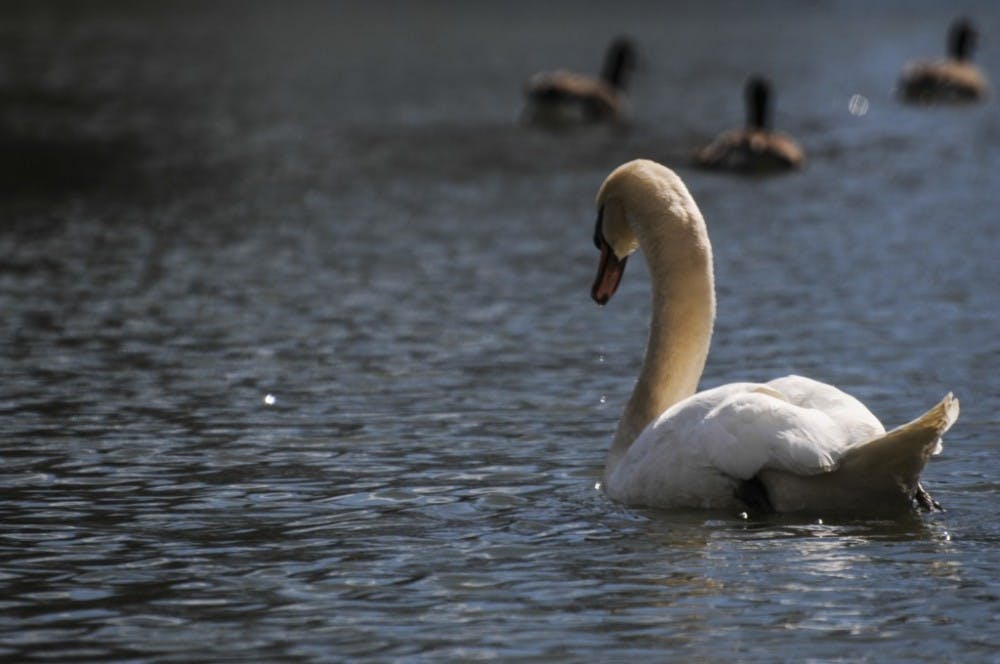Lake Mary Nell’s swan is a familiar presence. Her grace and beauty have charmed many who pass the lake. She dominates the area with her majestic features, and people are often compelled to stop and take a picture. Whether your interaction was limited to a picture, or if it extended to several minutes of swan-watching, you might have wondered, “Why is she alone?”
Though her lineage is uncertain, according to Tom Flood, director of landscaping at Elon University, her story began 10 years ago when two swans were brought to Lake Mary Nell to chase migrating geese off the lake.
One of these two swans was her mother. The second swan, her mother’s first mate, was known to venture beyond Mary Nell’s boundariesto look for nesting grounds. His search was cut short one day when he was killed by the swan’s greatest predator: the automobile.
After his death, Elon brought in a second male to Lake Mary Nell, which, according to Flood, is presumably the current swan’s father.
“It was really hard finding an adult ‘replacement swan,’ but we asked around and eventually found one,” Flood said. “We were still concerned for their safety though. The two swans would wander around in the spring and cross roads to look for nesting sites. We have had many swans over the years get injured or killed by cars.”
According to Flood, although the swans get their wings clipped as required by domestic law, their inability to fly has not stopped them from wandering — an activity characteristic of pairs.
“They can’t fly, but they sure can walk. You can’t really fence them in a pond. So if they get a notion that they’re going to go explore, they’ll do that. It tends to happen when there’s more than one in the pond,” Flood said.
Despite the threats posed by wandering, Flood said many swans have been successful in raising cygnets (baby swans).
“Typically, if swans have nested and have successfully hatched eggs, it’s a little difficult for them to raise a cygnet to adulthood,” he said. “Many of the cygnets would be killed by natural environmental conditions like the snapping turtles in the lake.”
The swan currently inhabiting Lake Mary Nell is one of the few cygnets who were raised to adulthood. Flood claims that even the cygnets who survived to semi-adulthood were often chased off the lake by the parent swans and were thus relocated to various areas, which include Danieley Center’s Lake Verona and Twin Lakes.
While many of the relocated swans wandered away from their new homes, the current swan is one of the few who have stayed — perhaps because she was kept where she was raised.
The turmoil brought by having pairs of swans on the lake helps to explain why there is only one swan in Lake Mary Nell today.
“It’s just much more peaceful now for everybody. There is less aggression going on in the lake, it’s safer for the swan because she doesn’t wander off, we’re not having cygnets that are succumbing to the rigors of nature,” he said. “Though the swan doesn’t chase the migrating geese, which was its intended purpose, it just became a tradition to have a swan on the lake.”
Though it appears that the swan and the geese live harmoniously on the lake, a rumor has emerged suggesting that perhaps the creatures are too content; many people have discussed the possibility of the geese mating with the swan and producing baby “sweese.”
According to Dave Gammon, associate professor of biology, the rumor is questionable.
“I’m skeptical of a swan hybridizing with a goose. Even if courtship behavior occurs, I have a hard time believing offspring would be produced, or that the offspring would be fertile,” Gammons said. “Each species is from a different genus, so it would be sort of like a dog hybridizing with a fox.”
Flood, who said he agrees with Gammon, urged students at Elon to realize that even though the swan isn’t nesting, she can still show territorial and aggressive behavior.
“I worry every time I see a family with little kids trying to feed the geese and the swan. They can get quite aggressive and their bite can really raise a good welp,” Flood said.
Sophia Spach, a junior at Elon, has experienced this herself while trying to feed the swan.
“She looks so beautiful, gently floating on the lake until she steps her huge webbed feet on the land, and then it’s like, ‘bam!’ in your face: ‘hello swan,’” Spach said. “She bit my leg a few times and my chest one time.”
Flood assured the public the waterfowl on the lake are definitely not starving and suggests that students avoid feeding them, as it can provoke aggressive behavior.
“The swan is fed chicken pellets every day, and, in the process, the ducks and geese are inevitably fed as well,” Flood said.
Flood said he is always amazed by the variety of rumors that have emerged over the years regarding the swan.
“It’s been 11 years since I came to Elon, and the swans came a year before I did,” he said. “Right now, I don’t see a lonely swan that’s planning to get away from Lake Mary Nell. I see a swan coexisting with all the other waterfowl on the pond and keeping safe from threats to her safety.”


